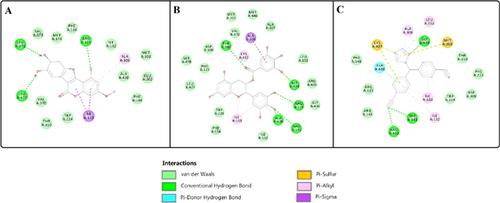Current Computer-Aided Drug Design ( IF 1.5 ) Pub Date : 2020-07-31 , DOI: 10.2174/1573409915666191015113134 Sadia Sarwar 1 , Tauqeer Amed 2 , Neelum Gul Qazi 2 , Jun Qing Yu 1 , Fazlul Huq 1

|
Background: Identification and development of new drug candidates to be used singly or in combination therapy is critical in anticancer research. In recent years, accumulating evidence encouraged us to investigate the anti-proliferative effects of a small and emerging phytochemical Wedelolactone (WDL) in estrogen-dependent and independent multiple gynecological tumor models.
Objective: The aim of this study was to investigate the growth inhibitory effect of WDL on estrogen- dependent and independent gynecological cell lines and to explore its inhibitory potential towards key targets through in silico study.
Methods: Cytotoxicity of WDL was investigated in human breast and ovarian cancer cell lines (MCF-7 and SKOV3) through 3-(4,5-Dimethyl-2-thiazolyl)-2, 5-diphenyl-2H-tetrazolium bromide (MTT) reduction assay. Epigallocatechingallate (EGCG) was used as reference natural compound while cisplatin was taken as a standard clinical agent. Both WDL and EGCG in combination with cisplatin were also evaluated for their combined growth inhibitory potential in MCF-7 cells. WDL was also evaluated in silico against key factors including braf kinases, CDPK, ERα, aromatase, topoisomerase II and dihydrofolate reductase (DHFR) playing pivotal roles in driving multiple tumors.
Results and Discussion: The IC50 value of WDL was 25.77 ± 4.82 μM and 33.64 ± 1.45 μM in MCF-7 and SKOV-3 respectively. The binding energy order was as follows; WDL: DHFR >Braf kinases > CDPK; aromatase > topoisomerase II> ERα > NFkB > alkaline phosphatase; EGCG dihydrofolatereductase (DHFR) > aromatase >CDPK > topoisomerase II > braf kinases > alkaline phosphatase > CDPK > ERα > NFkB.
Conclusion: We identified WDL as a cytotoxic agent in breast and ovarian tumor models with the potential to inhibit multiple targets in the oncogenic pathway including estrogen receptor ERα, as depicted through its in silico study. Based on our own research findings and from literature evidence, we conclude that further research should be encouraged to investigate different aspects of wedelolactone as an additional agent to be combined with antiestrogen/endocrine therapy.
中文翻译:

Wedelolactone作为妇科癌症的化学治疗剂的前景;来自其体外和计算机分析的线索。
背景:鉴定和开发单独使用或联合治疗的新药物候选物在抗癌研究中至关重要。近年来,越来越多的证据鼓励我们研究小型新兴的植物化学韦德内酯(WDL)在雌激素依赖性和非依赖性多妇科肿瘤模型中的抗增殖作用。
目的:本研究的目的是研究WDL对雌激素依赖性和独立妇科细胞系的生长抑制作用,并通过计算机模拟研究探索其对关键靶标的抑制潜力。
方法:通过3-(4,5-Dimethyl-2-thiazolyl)-2,5-diphenyl-2H-tetrazolium bromide(MTT)研究人乳腺和卵巢癌细胞系(MCF-7和SKOV3)中WDL的细胞毒性还原测定。将表没食子儿茶素(EGCG)用作参考天然化合物,而将顺铂作为标准临床药物。还评估了WDL和EGCG与顺铂的组合在MCF-7细胞中的组合生长抑制潜力。WDL还通过计算机模拟评估了关键因子,包括braf激酶,CDPK,ERα,芳香化酶,拓扑异构酶II和二氢叶酸还原酶(DHFR)在驱动多种肿瘤中起关键作用。
结果与讨论:MCF-7和SKOV-3中WDL的IC50值分别为25.77±4.82μM和33.64±1.45μM。结合能级如下:WDL:DHFR> Braf激酶> CDPK;芳香酶>拓扑异构酶II>ERα> NFkB>碱性磷酸酶; EGCG二氢叶酸还原酶(DHFR)>芳香酶> CDPK>拓扑异构酶II> braf激酶>碱性磷酸酶> CDPK>ERα> NFkB。
结论:正如其计算机研究所示,我们将WDL鉴定为乳腺癌和卵巢肿瘤模型中的一种细胞毒剂,具有抑制致癌途径中多个靶标的潜力,包括雌激素受体ERα。根据我们自己的研究结果和文献证据,我们得出结论,应鼓励进一步研究,以研究韦地内酯作为抗雌激素/内分泌疗法的辅助药物的不同方面。











































 京公网安备 11010802027423号
京公网安备 11010802027423号